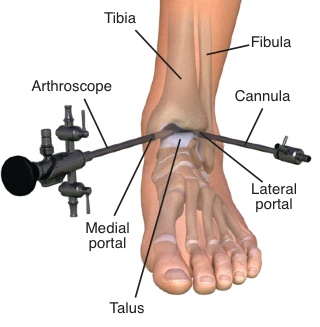You may need ankle arthroscopy surgery if you are experiencing ankle pain, limited motion or instability of your ankle. These symptoms may be caused by bone spurs, loose bone/cartilage, or inflammation of soft tissue.

Ankle arthroscopy surgery involves a few small incisions around the ankle and is performed under general anesthesia. Using a camera, your surgeon can see the inner tissues of the ankle on a monitor. Many problems can be diagnosed and corrected once the arthroscope is in place. The procedure will take approximately one hour and you will wake with a bulky dressing covered by an ace wrap on your ankle. Once you are awake and taking fluids, your IV will be removed and you will be allowed to go home. You will need someone to drive you home after surgery.
Pre-admission testing may be done before surgery to ensure that you are healthy enough for the planned procedure. Testing may include lab work, an EKG and a chest x-ray. You are encouraged to stop smoking before surgery to prevent lung complications or delayed healing. Please bring your surgical boot to surgery. Anti-inflammatory medications, aspirin and blood thinning medications should be stopped one week before your surgery unless otherwise specified by your doctor. These medications affect your blood clotting ability and could increase your risk for bleeding.
Please wear the surgical boot when you walk until you are seen for your first post-op appointment. Your surgeon may not allow you to bear weight on your foot and you may need to use crutches or a roll-about scooter until otherwise instructed. You may notice swelling and weakness of your ankle initially. You may move your ankle as tolerated while seated or lying down. Elevate your foot while you are seated and apply ice (20minutes on/20minutes off) to help with any swelling. The surgical dressing can be removed 24 hours after surgery and you may shower. Do not submerge your incisions in a bathtub/pool/hot tub until the stitches have been removed and the incisions are completely closed. Do not put lotions or antibiotic ointment on your incisions. Keep the incisions covered with band aids until they stop draining. When you can walk confidently in the boot, you may remove it to drive (as long as you are not taking narcotic pain relievers). You should have an appointment to see your surgeon 2 weeks after surgery to have your sutures removed.
Patients may return to work as soon as they feel comfortable. Patients with labor intensive jobs may require restrictions for the first few weeks following surgery which limit prolonged standing/walking, ladder climbing or repetitive stair climbing.
For additional information about treatment, we have included this complete patient eduction sheet as a pdf to view, download and print: